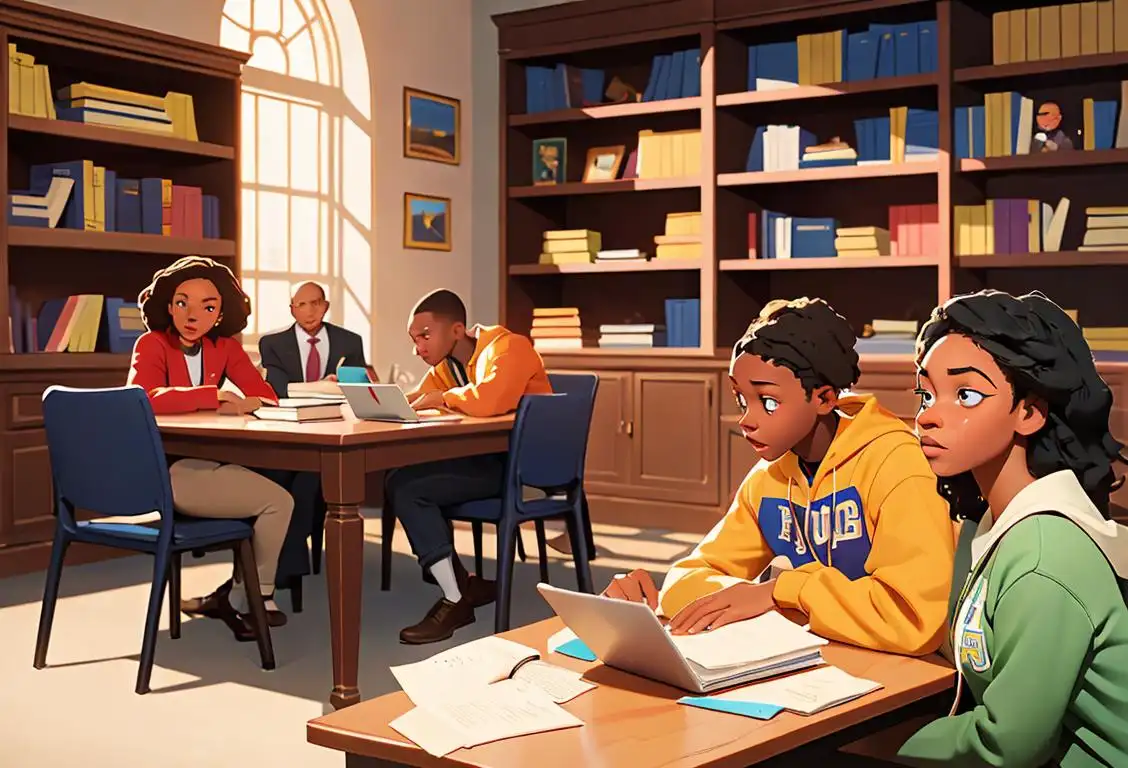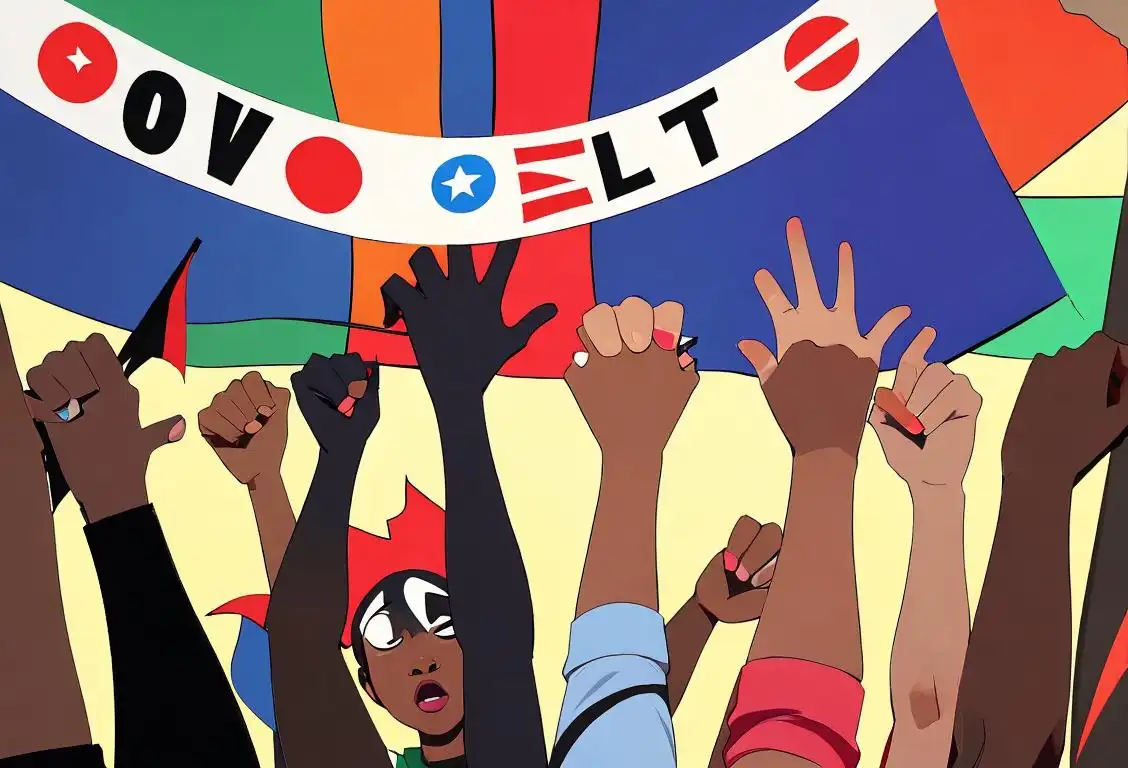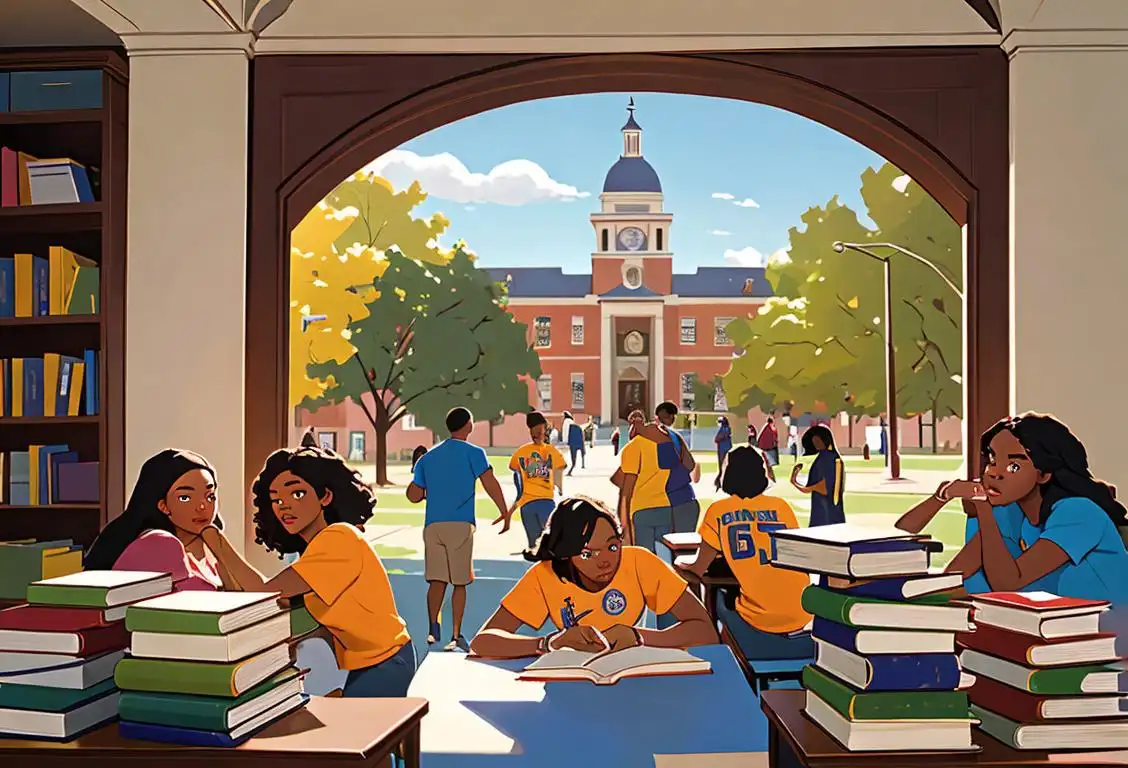National Apply To An Hbcu Day

Welcome to National Apply to an HBCU Day! This is the day where we celebrate and encourage students to explore the rich and vibrant history of Historically Black Colleges and Universities. So grab your books, dust off your thinking caps, and let's dive into the amazing world of HBCUs!
When is Apply To An Hbcu Day?
It's national apply to an hbcu day on the 21st February.
A Brief Introduction to HBCUs
Historically Black Colleges and Universities, or HBCUs, have played a vital role in shaping the educational landscape of the United States. These institutions were established during a time when African Americans were denied access to higher education, providing a safe haven for black students seeking knowledge and empowerment.
Although numerous HBCUs were founded in the mid-19th century, the importance and impact of these institutions continue to this day. HBCUs have produced a plethora of successful individuals who have gone on to make significant contributions in various fields, including politics, science, sports, and the arts.
Why Apply to an HBCU?
Choosing to apply to an HBCU means embracing a unique and enriching educational experience. HBCUs provide a supportive and nurturing environment, fostering a strong sense of community and belonging. These institutions offer a wide range of academic programs and resources to help students succeed both academically and personally.
Aside from exceptional academics, HBCUs are known for their vibrant campus life and rich cultural heritage. Homecoming celebrations, step shows, and Greek life are just a few examples of the lively atmosphere you'll find on an HBCU campus.
Applying to an HBCU
Ready to embark on your HBCU journey? Here are a few tips to guide you through the application process:
- Research and shortlist: Take the time to thoroughly research different HBCUs and identify the ones that align with your academic goals and interests.
- Connect with admissions offices: Reach out to admissions counselors at your chosen HBCUs. They can provide valuable insights and guidance throughout the application process.
- Gather required documents: As with any college application, make sure to compile all the necessary documents, such as transcripts, letters of recommendation, and personal essays.
- Submit your application: Once you've completed all the required steps, submit your application before the deadline.
Did You Know?
Did you know that National Apply to an HBCU Day was established to encourage more students, especially African American students, to consider attending an HBCU? This day serves as a reminder of the countless opportunities and support available at these remarkable institutions.
History behind the term 'Apply To An Hbcu'
1865
The establishment of the first HBCU
In 1865, just after the end of the American Civil War, the first Historically Black College and University (HBCU) was established. This institution, called Lincoln University, was founded in Pennsylvania by John Miller Dickey and Langston Hughes Sr. (not to be confused with the famous writer). Its purpose was to provide educational opportunities for African Americans who had been denied access to higher education for centuries.
1867
The establishment of the first HBCU
In 1867, the first Historically Black Colleges and Universities (HBCUs) were established in the United States. These institutions were founded primarily to provide higher education opportunities for African Americans who were previously denied access to white-dominated colleges and universities due to racial segregation and discrimination. HBCUs played a crucial role in shaping the history and culture of African Americans.
1837
The Founding
In 1837, the first historically black college or university (HBCU) was founded. Originally known as the Institute for Colored Youth, it was established on Cheyney University's current site in Cheyney, Pennsylvania. This marked the beginning of HBCUs, which were initially created to provide higher education opportunities for African American students during a time of systemic racial segregation.
1837
Founding of first HBCU
In 1837, the Cheyney University of Pennsylvania was founded, becoming the first Historically Black College or University (HBCU) in the United States. Cheyney University was established to provide African Americans with access to higher education during a time when segregation and discrimination were widespread. This marked a significant milestone in the fight for equal educational opportunities.
1867
Foundation of the first HBCU in the United States
In 1867, the first Historically Black College and University (HBCU), named Howard University, was established in Washington, D.C. It aimed to provide education for newly freed African Americans following the Civil War. Howard University set the foundation for future HBCUs by creating opportunities for African Americans to receive a higher education.
1837
Formation of Cheyney University
Cheyney University, originally known as the African Institute, was established in 1837 in Pennsylvania, making it the first historically black college and university (HBCU) in the United States. Its purpose was to provide educational opportunities for African Americans, who faced significant barriers to education at the time. Cheyney University set the stage for the term 'apply to an HBCU'.
1837
Founding of the First HBCU
In 1837, the first Historically Black Colleges and Universities (HBCUs) were founded. The Institute for Colored Youth, which later became Cheyney University of Pennsylvania, was the first HBCU established. While these institutions provided higher education for Black students during a time of widespread segregation, they faced many challenges due to limited resources and discriminatory practices.
1862
The founding of the first HBCU
In 1862, the first Historically Black Colleges and Universities (HBCUs) were founded in the United States. The Morrill Act of 1862 provided federal funds for the establishment of land-grant colleges, including several HBCUs. These institutions played a crucial role in providing higher education opportunities to African Americans, who were often denied admission to predominantly white institutions during the era of racial segregation.
1862
Morrill Act
In 1862, the Morrill Act was signed into law by President Abraham Lincoln. This Act provided federal land grants to states for the establishment of colleges and universities. These institutions were called land-grant colleges or land-grant universities and were created with the goal of promoting practical education in fields such as agriculture, engineering, and mechanics.
1890
Second Morrill Act
In 1890, the Second Morrill Act was passed by the United States Congress. This act granted federal funding to establish land-grant institutions for African Americans in states where racially segregated education was present. The institutions established under this act became known as HBCUs and played a vital role in providing education and support to African American communities.
1890
The Second Morrill Act
In 1890, the Second Morrill Act was passed by the United States Congress. This act required states with racially segregated educational systems to establish land-grant colleges for African Americans. These colleges later became known as 1890 Land-Grant Institutions or HBCUs. The term 'apply to an HBCU' gained relevance as these institutions provided diverse educational opportunities for African Americans.
1890
Second Morrill Act
In 1890, the Second Morrill Act was passed, which provided federal funding for land-grant institutions exclusively for Black students. This helped strengthen the educational opportunities for African Americans and further solidified the presence of HBCUs. The act required states to establish separate land-grant colleges for Black students if they were not allowed to attend the existing colleges designated for white students.
1965
The Civil Rights Act of 1964
The Civil Rights Act of 1964 was a landmark legislation that aimed to end racial segregation and discrimination. This act prohibited racial discrimination in public facilities, including educational institutions. As a result, African Americans gained legal rights and protections, allowing them to apply and enroll in universities of their choice, including HBCUs.
1862
Morrill Act
The year 1862 witnessed a significant step in the development of HBCUs. The Morrill Act, also known as the Land-Grant College Act, was signed into law by President Abraham Lincoln. The act aimed to make education more accessible by granting federal lands to states to establish colleges. This allowed the establishments of land-grant universities and provided a foundation for the future expansion of HBCUs.
1890
The Second Morrill Act
In 1890, the Second Morrill Act was passed, which required states with segregated higher education systems to provide land-grant funding for African American colleges, in addition to the funding provided for white institutions. This act further supported the growth and development of HBCUs, allowing them to expand their programs and resources for students.
1915
The term 'HBCU' enters the lexicon
In 1915, the term 'Historically Black College and University' (HBCU) was introduced to describe institutions of higher education that were founded to primarily serve African American students. The term was coined to recognize the historical significance of these institutions and their mission to provide education to Black communities.
1867
The expansion of HBCUs
In 1867, the second HBCU was established. This institution, called Howard University, was founded in Washington, D.C., by Oliver O. Howard. The establishment of Howard University marked a significant step forward for African American education, as it aimed to prepare students to contribute to society and make a real impact. With the establishment of Howard University, the HBCU movement gained momentum, and more HBCUs were established across the United States in the coming years.
1890
Second Morrill Act
In 1890, the Second Morrill Act was passed, which required states to provide land-grant benefits to African American students. This act specifically aimed to address the racial inequality in higher education and paved the way for the establishment of historically black colleges and universities (HBCUs). The Second Morrill Act provided funding and support for the development of HBCUs to ensure that African American students had access to higher education.
1965
HBCU's significance recognized by federal legislation
In 1965, the Higher Education Act was signed into law as part of President Lyndon B. Johnson's Great Society initiatives. The act acknowledged the important role HBCUs played in promoting equal access to education and allocated federal funding to support their development and growth.
1980s
Increased government support for HBCUs
During the 1980s, the United States government recognized the importance of HBCUs in promoting educational opportunities for African Americans. As a result, government funding and support increased for these institutions. This support helped HBCUs to expand their programs, improve infrastructure, and enhance the overall educational experience for their students.
1954
Brown v. Board of Education
The Supreme Court's landmark decision in 1954, Brown v. Board of Education, declared racial segregation in public education unconstitutional. This ruling greatly impacted HBCUs as it led to the integration of previously segregated educational institutions. However, many African American students continued to 'apply to an HBCU' due to the unique cultural environment and academic opportunities they offered.
1944
The G.I. Bill
After World War II, the Servicemen's Readjustment Act of 1944, commonly known as the G.I. Bill, was enacted to provide educational benefits for veterans. This legislation allowed African American veterans to enroll in HBCUs, leading to a significant increase in student enrollment and further establishing these institutions as centers of academic excellence and cultural heritage.
1915
Term 'HBCU' coined
The term 'Historically Black College or University' (HBCU) was coined in 1915 by Mary McLeod Bethune, an African American educator and civil rights leader. She used the term to refer to institutions of higher education that were founded primarily to educate African Americans before the Civil Rights Act of 1964 and the desegregation of schools.
Historical Period of Early 20th Century
Racial Segregation
During the early 20th century, racial segregation was deeply entrenched in American society, including in the education system. Many universities and colleges practiced racial discrimination and excluded African American students from admission. As a result, HBCUs became crucial institutions for African American students aspiring to obtain a college education. HBCUs provided a safe and welcoming environment for African American students, nurturing their intellectual growth and fostering their leadership skills.
1890
The Second Morrill Act
In 1890, the Second Morrill Act was enacted, leading to the establishment of additional HBCUs across the southern United States. This act provided federal funding for the creation of land-grant colleges for African Americans, as the original Morrill Act of 1862 only benefited predominantly white institutions. The Second Morrill Act aimed to address the racial disparities in education and create opportunities for African Americans to receive higher education.
1890
The Second Morrill Act
In a continued effort to expand educational opportunities for African Americans, the Second Morrill Act was passed in 1890. This act required states with racially segregated educational systems to provide land-grant funding for colleges that served African American students. The Second Morrill Act led to the establishment of numerous HBCUs across the United States.
1915
The Harbinger of HBCU Application
By 1915, many HBCUs had been established, including Howard University, Tuskegee University, and Morehouse College. These institutions played a pivotal role in nurturing the intellectual, cultural, and social growth of Black communities. As the demand for higher education among African Americans grew, so did the necessity for students to apply to HBCUs as a means to pursue their academic and career aspirations.
1954
Brown v. Board of Education
The landmark Supreme Court case of Brown v. Board of Education in 1954 rejected racial segregation in schools and deemed it unconstitutional. This ruling marked a significant turning point for the civil rights movement. While the decision aimed to desegregate public schools, HBCUs continued to serve as vital educational institutions for African American students, offering quality higher education and cultivating a sense of identity, pride, and community.
1964
The Civil Rights Act
The passage of the Civil Rights Act in 1964 outlawed racial segregation and discrimination in public facilities, including colleges and universities. This landmark legislation opened up opportunities for African Americans to apply to any college or university of their choice, including HBCUs. While HBCUs faced challenges in the post-Civil Rights Act era, they continued to serve as important educational and cultural institutions for African American students.
1954
Brown v. Board of Education
The landmark Supreme Court case, Brown v. Board of Education, decided in 1954, marked a significant turning point in the fight against racial segregation in education. The ruling declared that segregation in public schools was unconstitutional, leading to the integration of schools across the United States. While this decision aimed to create equal educational opportunities for all, it also impacted the enrollment dynamics of HBCUs.
20th Century
Rise and Evolution of HBCUs
Throughout the 20th century, HBCUs played a crucial role in the advancement of Black communities and the fight for civil rights. These institutions provided a platform for African American intellectuals, activists, and leaders to develop their skills and foster a sense of community. Notable figures such as Dr. Martin Luther King Jr., Thurgood Marshall, and Oprah Winfrey attended HBCUs or had affiliations with them. HBCUs continue to be highly respected centers of education and cultural growth.
1970s
Increasing enrollment and diversity at HBCUs
During the 1970s, HBCUs experienced a significant increase in enrollment, not only from African American students but also from students of diverse backgrounds. These institutions became desirable options for students seeking a unique educational experience, cultural enrichment, and a strong sense of community.
1964
Desegregation begins
In 1964, the Civil Rights Act was signed into law, prohibiting racial segregation and discrimination in public facilities, including educational institutions. This marked a significant turning point in the history of HBCUs. As more opportunities for integration arose, the enrollment rates at HBCUs started to decline. However, these institutions remained crucial in providing quality education and nurturing African American heritage and culture.
1965
Higher Education Act of 1965
The Higher Education Act of 1965 provided federal funding to HBCUs, enabling them to expand their programs, infrastructure, and student enrollment. This support played a significant role in strengthening the HBCU system and increasing accessibility to higher education for African Americans. Consequently, the term 'apply to an HBCU' became more commonly used as a pathway for pursuing quality education.
1922
The Association of Negro Colleges and Universities (ANCU)
In 1922, the Association of Negro Colleges and Universities (ANCU) was founded. The ANCU, later renamed the United Negro College Fund (UNCF), was formed to provide financial assistance and support to HBCUs. The organization's mission is to increase minority representation in higher education and ensure equal educational opportunities for all students. Through scholarships, grants, and advocacy, the UNCF has played a crucial role in advancing the mission and success of HBCUs.
Early 21st century
Growing popularity and recognition of HBCUs
In the early 21st century, HBCUs gained increased recognition and popularity among students of all races. These institutions became renowned for their strong academic programs, nurturing environments, and vibrant cultural experiences. As a result, more students from diverse backgrounds started to apply to HBCUs, appreciating the rich history, cultural heritage, and educational opportunities offered by these institutions.
2020
Continued Relevance
In recent years, 'apply to an HBCU' has continued to hold cultural significance. HBCUs have produced notable alumni who have excelled in various fields, from civil rights activists to renowned artists and successful professionals. HBCUs are celebrated for their commitment to fostering inclusivity, empowerment, and cultural heritage, making 'apply to an HBCU' a choice that represents a desire for a unique educational experience and connection with African American history.
Present Day
Continued Relevance
Today, applying to an HBCU holds profound cultural significance. HBCUs have a rich history and have produced countless influential leaders, intellectuals, and trailblazers who have made significant contributions to various fields. These institutions play a vital role in fostering academic excellence, nurturing cultural awareness, and promoting social progress. Applying to an HBCU offers students the opportunity to be part of a distinguished legacy and to receive an education rooted in African American history, culture, and traditions.
2021
Continued relevance and impact of HBCUs
Today, HBCUs continue to play a vital role in higher education, producing a significant number of African American professionals, leaders, and scholars. They have a rich legacy of nurturing talent, fostering cultural pride, and addressing social justice issues. The term 'apply to an HBCU' represents the choice and opportunity for individuals to pursue education at these esteemed institutions and contribute to their continued impact.
Today
Applying to an HBCU
Today, applying to an HBCU involves a multi-step process that varies from institution to institution. Prospective students must typically complete an application form, provide academic transcripts, submit standardized test scores, and write personal essays. Many HBCUs also consider extracurricular activities and letters of recommendation. The application process reflects the continued value and importance of HBCUs in providing quality higher education for African American students and fostering diverse communities.
Present
Continued significance and relevance of applying to an HBCU
Today, applying to an HBCU continues to hold great significance and relevance. Many students recognize the value of attending an institution that celebrates African American culture, provides a supportive community, and fosters academic excellence. HBCUs have produced countless notable alumni who have made significant contributions to various fields, including civil rights, politics, arts, and sciences. Applying to an HBCU is not only a personal choice but also a chance to become a part of a rich historical legacy and contribute to the academic advancement of individuals from historically marginalized communities.
1964
The Civil Rights Act and HBCUs
In 1964, the Civil Rights Act was passed, prohibiting racial discrimination in public institutions, including higher education. This legislation further bolstered the importance of HBCUs as educational institutions that encouraged African American enrollment and provided quality education. With the provisions of the Civil Rights Act, HBCUs gained recognition and support as vital institutions for promoting equality and fostering academic excellence.
1965
Higher Education Act of 1965
The Higher Education Act of 1965 was a crucial piece of legislation that aimed to expand access to higher education for all Americans, regardless of race, color, or national origin. This act provided federal funding to HBCUs and other institutions serving minority populations. The legislation paved the way for more students to apply to HBCUs, helping to strengthen their ability to provide quality education and support to a diverse student body.
1980s
Expansion of academic programs
In the 1980s, HBCUs experienced a surge in expansion of academic programs. These institutions began to offer a wider range of courses, including professional programs in fields like business, law, medicine, and engineering. The expansion of academic programs contributed to the continued relevance and importance of HBCUs in preparing and empowering African American students for successful careers.
Today
Applying to an HBCU
Today, applying to an HBCU means seeking admission to one of the prestigious and historically significant institutions that have been instrumental in shaping the educational landscape for African Americans. HBCUs offer a unique and supportive environment that celebrates the culture, history, and achievements of Black communities. They continue to provide quality education and cultivate future leaders in various fields, contributing to the advancement and empowerment of African Americans.
Present
The continued significance of HBCUs
Today, HBCUs continue to be instrumental in providing higher education opportunities for African American students. These institutions have produced countless accomplished individuals who have made significant contributions to various fields, including science, arts, politics, and sports. HBCUs serve as a reminder of the resilience, determination, and triumph of the African American community in their pursuit of education and equal rights.
2000s
Growing Popularity and Diversity
In the 2000s, HBCUs gained increased recognition and popularity among students from diverse backgrounds, regardless of race. These institutions offered unique academic programs, rich cultural experiences, and strong community bonds. The application process for HBCUs became more accessible through online platforms, allowing students from across the country to explore and apply to these historic institutions.
Present
Increasing recognition and support
In the present day, HBCUs continue to hold a significant place in American higher education. They are recognized for their contributions to African American culture, producing influential alumni, and providing a supportive and inclusive learning environment for students. The importance of HBCUs is increasingly acknowledged, leading to initiatives focused on their funding, resources, and overall support to ensure their ongoing success.
Did you know?
Did you know that Barack Obama, Oprah Winfrey, and Martin Luther King Jr. are just a few notable HBCU alumni who have made a tremendous impact on society?Tagged
education diversity empowermentFirst identified
21st February 2020Most mentioned on
21st February 2020Total mentions
63Other days
Apply To An Hbcu Day
Women In Engineering Day
Black Voter Day
Girl Child Girl Child Day
Girls In Ict Day
African American Read In Story Of The Day
Introduce A Girl To Engineering Day
Hbcu Day
Teacher Day
Education Day








